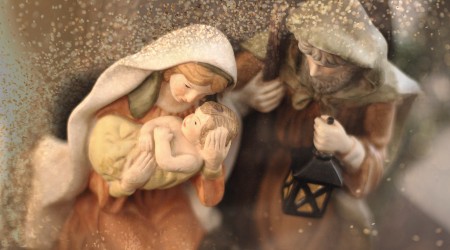Saving lives in the great outdoors
FREE Catholic Classes
McClatchy Newspapers (MCT) - Dr. Brian Horan gave the medical students a few minutes to grab what they'd need to treat patients for their final class exam: duct tape, hiking poles, some rope.
Highlights
McClatchy Newspapers (www.mctdirect.com)
9/26/2008 (1 decade ago)
Published in Health
Not your typical medical supplies. But this was no ordinary medical school course.
During a two-week medical boot camp at the Wawona Campground in Yosemite National Park, the fourth-year medical school students had to treat three "injured" hikers in the pine forest using only rudimentary first-aid supplies they carried in back packs.
Teaching the outdoors class is part Horan's job as University of California at San Francisco-Fresno's first wilderness and emergency medicine fellow.
The one-year fellowship is the newest addition to the only program in the country that offers medical training for park rangers. And it comes as more medical schools recognize the need to graduate doctors who are comfortable treating snake bites, hypothermia and broken bones amid growing interest in outdoor and wilderness activities.
The fellowship at the Fresno campus of the university involves treating patients as well as working with emergency medical technicians and park rangers in the ParkMedic program.
It's a good fit for Horan, 35, who spends much of his time mountain climbing, bicycling or scuba diving when he's not treating patients in the trauma center at Community Regional Medical Center in downtown Fresno, Calif.
"In the ER, you see a lot of things that can happen in the outdoors," Horan said.
The proximity of the medical school in Fresno to national parks _ Yosemite, Kings Canyon and Sequoia _ made it a good fit for a wilderness fellowship, said Dr. Lori Weichenthal, who directs the fellowship.
Weichenthal wants to do even more with the program. She envisions adding wilderness medicine classes for volunteers who participate in search-and-rescue missions. UCSF-Fresno could "become a center of excellence for wilderness training," she said.
And she hopes Horan _ who completed a four-year residency in emergency medicine at UCSF-Fresno last year _ will stay on permanently to help the program grow.
AN EXPANDING FIELD
Up until two years ago, there was only one wilderness medicine fellowship in the country connected to an academic institution. Fresno's program now makes the sixth.
Stanford University offered the first fellowship five years ago. The University of Utah added a program two years ago and Harvard Medical School started one earlier this year.
A growing outdoor recreation industry is helping to fuel the proliferation of wilderness fellowship programs, said Loren Greenway, chief executive officer of the Wilderness Medical Society in Salt Lake City. The society provides guidelines for wilderness medical education and offers its own fellowship program.
More of the public is venturing into wilderness areas for recreation, he said. And doctors recognize "there's a need to have people with good wilderness medical skills."
National parks had 223.7 million recreation visits between June and September 2007, an increase of 2.8 million visits from 2006.
While nobody tracks wilderness-related injuries or deaths, a study of outdoor recreational injuries treated in emergency departments in the U.S. in 2004 and 2005 found an estimated 212,708 people were treated each year. The activities that resulted in the most injuries: snowboarding, sledding and hiking.
Medical students also are looking for a more stimulating environment in which to practice medicine than in a traditional hospital setting, Greenway said. "People who seek these fellowships are usually emergency medicine practitioners who want to combine medicine with their passion for the wilderness."
The two-week UCSF-Fresno wilderness medicine class has become increasingly popular in the five years she's offered it, Weichenthal said. The class attracted about 10 applicants the first year. This year, 30 students applied and 14 were chosen, she said.
Lauren Carpenter, 30, doesn't plan to practice emergency or wilderness medicine, but she signed up for the course. "I like playing outside," she said. And the class teaches "inventiveness with what resources you have at hand. And you get practice in hands-on skills," she said.
For Stacie Solt, 27, who plans to practice pediatric emergency medicine, the class was life-changing.
"This has been an amazing experience," she said. "At some point, it stopped being just about wilderness medicine and more about teamwork."
Medicine on the wild side
Earlier this month, the medical students split into teams for one last time to put the wilderness medical skills they'd acquired over the two weeks to a final test.
After a short hike from camp, they were briefed on their medical mission. Horan, Weichenthal and Rawnie Ruegner, a fourth-year medical resident, would pretend to be a brother and two sisters injured while hiking.
Horan's mock injuries were a dislocated knee and broken wrist.
Weichenthal feigned a broken ankle and broken ribs. Ruegner had a broken leg and dislocated shoulder.
The "injuries" meant the doctors could not walk out of the woods on their own power.
"We tried to make the injuries so they had to carry us out, put on splints, check airways and necks for injuries," Horan said.
From what the students carried in backpacks or could find in the forest, they had to fashion splints and slings to stabilize broken bones and rope litters to carry the doctors out of the woods.
Before they had left camp, each student picked one thing from a pile of camping supplies. A couple of students took rolls of duct tape_good for wrapping bandages around dislocated limbs. Others grabbed hiking poles for making splints.
One team of students found Horan sprawled near a rotting fallen tree. He said he couldn't bend his right knee and winced when he tried to move his left wrist. Ruling out Horan's injuries as life threatening, the students devised a way_using a sleeping-bag mattress pad as a seat_to get the doctor up a steep hill covered in pine needles.
Horan said he doesn't expect the students will necessarily choose careers in wilderness medicine, but they can apply what they learned to other situations, such as treating victims at the scenes of automobile accidents, he said.
Gerin River, 33, said the wilderness class gave him an opportunity to practice skills he can use for a career in international medicine. In undeveloped countries, patients can be miles from hospitals and in need of care, he said.
Besides teaching the medical students how to save lives in the outdoors, Horan and Weichenthal said they hoped the future doctors enjoyed the wilderness experience.
"They work really hard as medical students," Horan said, "and they should have a little fun while they're doing it."
___
© 2008, The Fresno Bee (Fresno, Calif.).
Join the Movement
When you sign up below, you don't just join an email list - you're joining an entire movement for Free world class Catholic education.

-

-
Mysteries of the Rosary
-
St. Faustina Kowalska
-
Litany of the Blessed Virgin Mary
-
Saint of the Day for Wednesday, Oct 4th, 2023
-
Popular Saints
-
St. Francis of Assisi
-
Bible
-
Female / Women Saints
-
7 Morning Prayers you need to get your day started with God
-
Litany of the Blessed Virgin Mary
The Deacon Saint Stephen the Proto-Martyr is a Model for all Christians
-

Love is Born on Christmas Morn, and the World is Born Anew
-

Rediscovering the True Importance of Christmas for Catholics
-
5 Ways to keep Jesus in your Christmas celebrations this year
-
Get your oven mitts ready, it's time to bake Christmas cookies!
Daily Catholic
 Daily Readings for Saturday, December 28, 2024
Daily Readings for Saturday, December 28, 2024 St. Anthony the Hermit: Saint of the Day for Saturday, December 28, 2024
St. Anthony the Hermit: Saint of the Day for Saturday, December 28, 2024 Litany to the Sacred Head of Jesus: Prayer of the Day for Saturday, December 28, 2024
Litany to the Sacred Head of Jesus: Prayer of the Day for Saturday, December 28, 2024- Daily Readings for Friday, December 27, 2024
- St. John the Apostle: Saint of the Day for Friday, December 27, 2024
- Glory be to the Father: Prayer of the Day for Friday, December 27, 2024
![]()
Copyright 2024 Catholic Online. All materials contained on this site, whether written, audible or visual are the exclusive property of Catholic Online and are protected under U.S. and International copyright laws, © Copyright 2024 Catholic Online. Any unauthorized use, without prior written consent of Catholic Online is strictly forbidden and prohibited.
Catholic Online is a Project of Your Catholic Voice Foundation, a Not-for-Profit Corporation. Your Catholic Voice Foundation has been granted a recognition of tax exemption under Section 501(c)(3) of the Internal Revenue Code. Federal Tax Identification Number: 81-0596847. Your gift is tax-deductible as allowed by law.







 Daily Readings for Saturday, December 28, 2024
Daily Readings for Saturday, December 28, 2024 St. Anthony the Hermit: Saint of the Day for Saturday, December 28, 2024
St. Anthony the Hermit: Saint of the Day for Saturday, December 28, 2024 Litany to the Sacred Head of Jesus: Prayer of the Day for Saturday, December 28, 2024
Litany to the Sacred Head of Jesus: Prayer of the Day for Saturday, December 28, 2024

